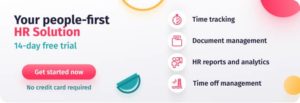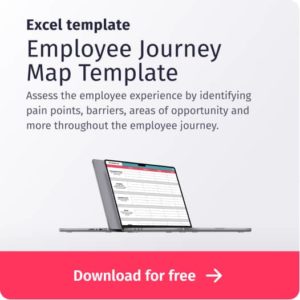Turnover rates have been rising since the pandemic. Part of this is down to inadequate compensation and increasing demands for employee well-being. However, another common reason is a lack of opportunities for growth and progression. Many employees are looking elsewhere because they don’t feel valued; there is no room for them to develop professionally. To combat this trend, many businesses are now implementing an internal talent mobility program to encourage employees to stay.
So, what is internal talent mobility and how can it benefit you?
In this step-by-step guide, we are going to share everything you need to know about internal talent mobility programs. We will explain what they are and how you can design and implement your own. We will also take a look at a few common challenges and share some internal talent mobility best practices to help you optimize your program.
Let’s get started.
What is internal talent mobility?
A degree of turnover in a business is nothing new. However, many organizations lately are reporting a substantial rise in their turnover rate. In fact, Gartner predicted a 20% increase last year. And this is resulting in skills gaps (as we have seen with the current physician shortage) and impacting company morale. Voluntary turnover is also expensive; US businesses spend a trillion dollars a year to rehire employees who hand in their notice. And in many cases, this is an unnecessary expense.
One solution that can be very effective for reducing your voluntary turnover rate is implementing a robust internal talent mobility program.
Before we explain what these programs are, let’s start by answering the question “What is internal talent mobility?”.
Internal talent mobility is the internal transfer of employees to other jobs within a company. This might include moving to other positions or projects, lateral job swaps, shadowing, or horizontal promotions.
An internal talent mobility program supports this concept and enables companies to develop an environment where employees are able to move between roles. Initiatives for this include developing leadership support, promoting learning and development, improving communication, and creating a culture that supports mobility and talent development.
With the right approach, an internal talent mobility program can open up new opportunities for growth and development, especially in terms of upskilling and reskilling. This in turn can promote employee empowerment, enhance the employee experience, and boost retention levels. It can also help organizations fill crucial skills gaps and reduce their external hiring costs.
Guide to building an internal mobility program
A successful internal talent mobility program enables managers to better understand the skills, motivations, and professional needs of their teams. It demonstrates to employees that you care about their growth and development, and it promotes equal opportunities for all. Ultimately, it’s about understanding where there are skills gaps in your organization, which employees show potential for growth, and how you can best develop this potential for the good of your business.
Here’s everything you need to do to build your own internal talent mobility program.
Define the type of internal talent mobility program
The first step is deciding what type of internal talent mobility program you are going to implement.
Generally speaking, there are three types of internal mobility:
- Vertical mobility: A promotion to a higher level within the company with more responsibility. For example, a sales rep is promoted to sales manager. This is the most common form of internal mobility.
- Horizontal mobility: A transfer to another role or department with the same level of responsibility. Usually as a result of a career change or because an employee wants a new challenge. For example, a graphic designer transferring from the marketing department to the product design team.
- Functional mobility: A temporary transfer driven by specific business needs. This might be to work on a specific short-term project or to cover an employee on parental leave, for example.
Ideally, you should aim to include all three types in your internal talent mobility program. That way, your workforce has access to maximum opportunities to grow and develop.
Get management on board
The next step involves getting management on board. This is important because any major cultural shift needs to develop from the top down. Make sure all your managers understand what your internal talent mobility program is, why you are implementing it, and what the specific benefits of driving internal mobility are.
Also, remind them that talent hoarding is not allowed, and they need to support the growth and development of their team members. Even if it’s at the cost of losing talented employees from their department.
Audit your existing talent map
Once you’ve got your managers on board, it’s time to get started with the planning side of things.
Start by auditing your current talent map. Talent mapping is a useful tool for planning your short, medium, and long-term hiring needs. Which positions are likely to open up in the future? Which profiles will you be looking for? What skills will you need? Essentially, this will help you bridge the gap between where you are now and where you want to be. That way, you can hire the right people to get you there.
This is also a good opportunity to review the tools and technology that you will use to support your internal talent mobility program. Do you use an applicant tracking system that can be adapted to internal hiring? What tools do you use for performance management? What about learning and development?
Perform a skills gaps analysis
Once you’ve identified what skills you need, it’s time to evaluate which ones your organization already has. The best way to do this is to perform a skills gap analysis. This will help you work out which skills you need to develop and where your current L&D program might be lacking. The aim is to identify employees with potential for growth so that you can offer them upskilling and reskilling opportunities. This will help you close your skills gaps and prepare more employees for potential internal mobility opportunities.
Improve your learning and development programs
An internal talent mobility program is only as effective as the learning and development program behind it. Without the right training, your employees won’t be able to develop and grow professionally. And that means that when someone leaves your company, you will have no choice but to recruit their replacement externally. And this can be costly. It can also take a lot longer than filling a position internally.
Once you’ve defined your skills gaps and identified employees with upskilling and reskilling potential, create personalized L&D programs for them. With the right training, they can develop their skills and fill any gaps in your organization. Ultimately, the more employees you develop through your L&D programs, the more potential internal candidates you will have for future vacancies.
Advertise your internal vacancies
Make sure you clearly advertise all your internal vacancies. These vacancies should be as visible as possible. Otherwise, if employees aren’t aware of them, then they won’t be able to apply.
There are a few channels you can use for this. If you have noticeboards in common areas, post hard copies of all your vacancies there. Send out group emails whenever a vacancy opens up so that everyone, including your remote employees, has visibility. If you have an intranet, post your vacancies there too. The same goes for any other communication platforms that you use such as Slack.
The more you advertise your internal vacancies, the higher the chance that your internal talent mobility program will be a success.
Promote your internal talent mobility program
Don’t stop at advertising vacancies. Make sure your employees understand what your internal talent mobility program is and why you have implemented it. Explain the rules and guidelines. This includes how they should apply and what the eligibility requirements are. Get the word out and educate them on the benefits of internal mobility.
Also, make sure your managers discuss internal mobility during performance appraisals. This will help them understand the expectations of their employees and where there might be opportunities for growth and development. Plus, these sessions are a great opportunity for employees to voice their opinions and proactively seek transfer and promotion opportunities.
Measure the success of your internal talent mobility program
Once you’ve launched your internal talent mobility program, it’s important to monitor progress to see if it is working well. That way, you can identify areas for improvement and get the most from the initiative.
The best way to do this is by using data.
For example, you should track the following metrics to measure the impact of internal mobility on your business:
- Overall employee retention and turnover rates.
- The retention rate of external hires vs. internal transfers and promotions.
- Employee satisfaction levels, especially in relation to the program. Regular short surveys can be a great tool for collecting this feedback.
- The number of employees participating in the program compared to the total number of eligible employees.
- Performance levels of transferred and promoted employees.
- Overall improvements to workflow efficiency, productivity, and cost savings.
Develop a culture that supports internal talent mobility
Finally, make sure you continuously nurture a culture that supports internal talent mobility. Offer training where needed and clearly communicate the benefits on a regular basis. Remind employees that you support employee growth and development. Encourage them to seek opportunities, not wait for them to be offered. And promote transparency at every level of your internal talent mobility program. Your employees need to understand that these opportunities are open to all who are willing to put in the work to develop their skills.
With the right approach, you can develop a culture where employees see you as a long-term employer who cares about their development.
Common challenges with internal talent mobility programs
One of the biggest challenges that many organizations point to is resistance from management. For example, managers can sometimes be unwilling to let go of their top performers. As a result, they prevent them from transferring to other departments or other positions. This is concerning when you consider that a 2022 report by McKinsey has highlighted the importance of internal mobility in organizations.
A lack of leadership support can also be a challenge as the program can only be as effective as the people behind it. The same goes for organizational culture. An internal talent mobility program is only going to work if everyone is on board. Otherwise, you won’t be able to create the nurturing environment you need for promoting internal mobility. That’s why it’s so important to communicate the benefits of these programs to every level of the business.
Another common challenge is a lack of transparency and guidelines for internal mobility. In fact, according to a study conducted by Deloitte, 59% of respondents rated their organization “fair” or “inadequate” at enabling internal mobility. Employees need to understand how the program works and what the rules are.
Moreover, companies need to improve the methods they use to identify opportunities for L&D, upskilling, and reskilling. They also need to focus more on performance management and collect regular employee feedback. The same goes for advertising internal vacancies. Unless there is a transparent system in place then employees won’t be aware of potential opportunities for internal mobility.
As we saw above, you need an organized strategy before you can build a successful internal talent mobility program. You also need access to the right technology to support all these processes.
Internal talent mobility best practices
Here are a few internal talent mobility best practices to help you enhance your program and avoid the challenges we just mentioned.
- Make sure your managers understand the benefits of building an internal talent mobility program. This will help them get on board with the initiative so that you can develop the right culture at every level of your organization.
- Raise general awareness and make sure your employees understand all the rules and guidelines. Employee resources groups can be a great way to educate your workforce about your internal talent mobility program.
- Foster a company-wide culture of transparency. Be clear about all your internal vacancies. If an employee applies for a transfer but they are not successful, provide open and honest feedback.
- Promote lateral mobility. Not everyone wants to climb the ladder. Some employees might be happy with the level they are at, but still want opportunities to work in another department and learn new skills.
- Assess potential when you interview external candidates. Don’t just consider what they are capable of now; think about what they could be capable of in the future with the right guidance and development.
- Conduct regular performance reviews. These sessions will help you identify upskilling and reskilling opportunities. This will enable you to determine which employees might be suitable for internal mobility. It’s also important to collect regular feedback from your employees to understand their growth expectations.
- Encourage employees to take responsibility for their own development. Although organizational support is vital, remind employees that they have to communicate their aspirations and drive their careers forwards, too.
- Include internal mobility at every stage of the employee lifecycle. This includes recruitment, onboarding, performance management, succession planning, learning and development, and offboarding.
- Use the right tools and technology to support and manage your internal talent mobility program.
Develop talent with Factorial
Let’s finish by expanding on the last point we just made in the list of internal talent mobility best practices.
It’s important to use the right tools and technology to support and manage your internal talent mobility program. The right solutions can help you identify skills gaps, monitor employee performance, track L&D, and manage your internal mobility application process.
For example, Factorial’s applicant tracking system (ATS) can be a great way to streamline your internal application process. You can use it to create an internal hiring page, post vacancies, collect internal mobility applications, and track employees at each stage of the hiring pipeline.
Our comprehensive HRIS includes learning and development tools that you can use to manage your internal talent mobility program. In fact, it can help you with every aspect of L&D, including managing training activities, tracking individual training progress, and monitoring costs. Plus, you can use our skills matrix to identify skills gaps and opportunities for mobility. And you can send out follow-up surveys to collect training feedback. All this can help you develop a robust L&D program that encourages and supports employee growth and development.
Finally, our software also includes tools for performance management. This can help you measure the impact of your L&D initiatives on individual performance. You can keep a closer eye on employee development and identify which employees are on track for potential internal mobility opportunities.
All in all, with the right strategy and the right tools to support your processes, it’s actually very easy to implement an internal talent mobility program that promotes employee development. That way, you can enhance your employee experience, increase retention, and develop a multi-skilled workforce that takes your business to the next level.



